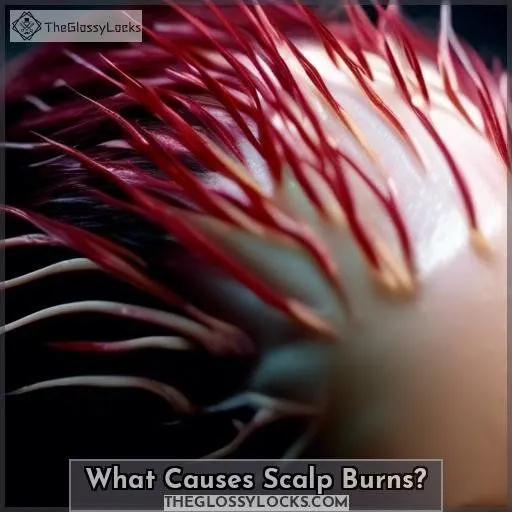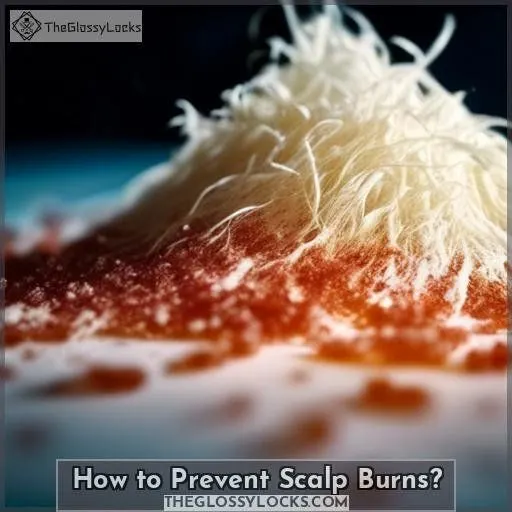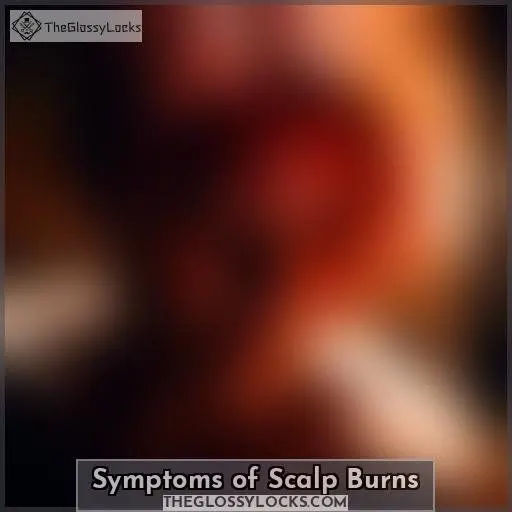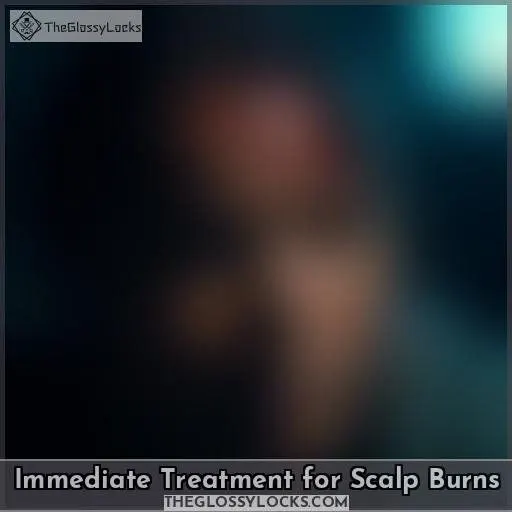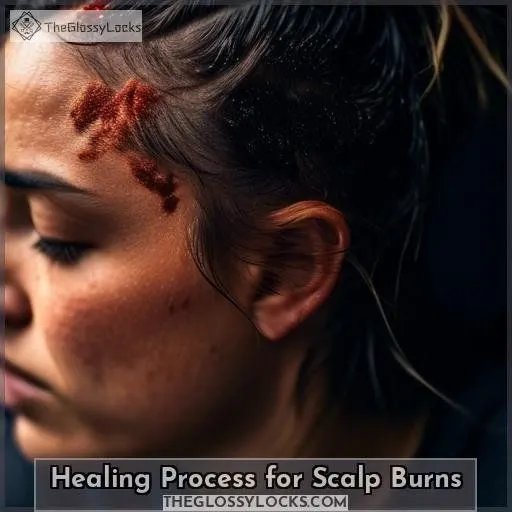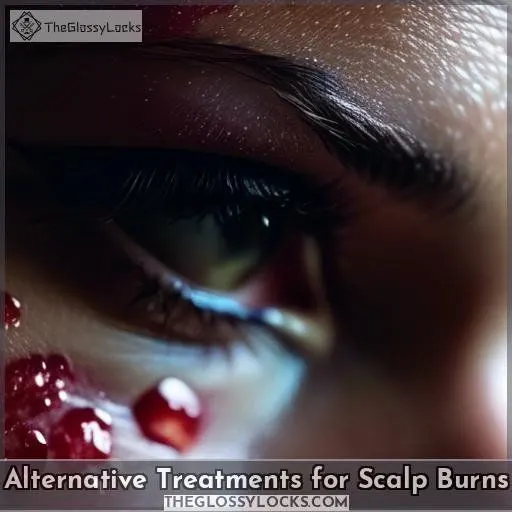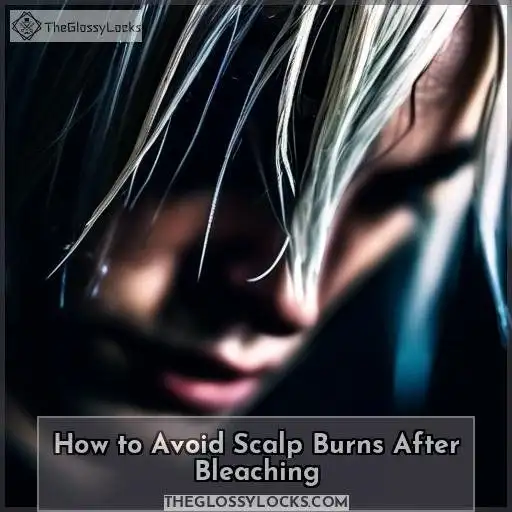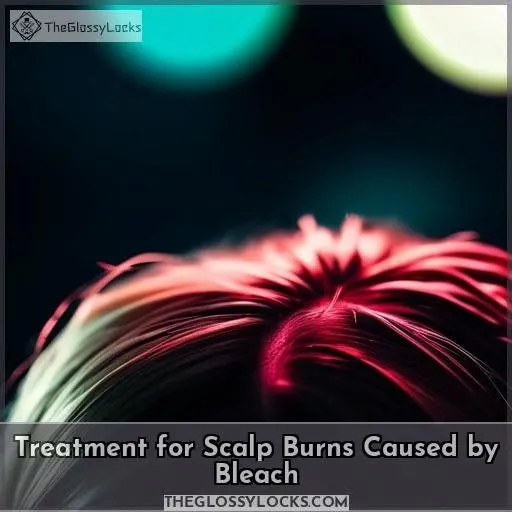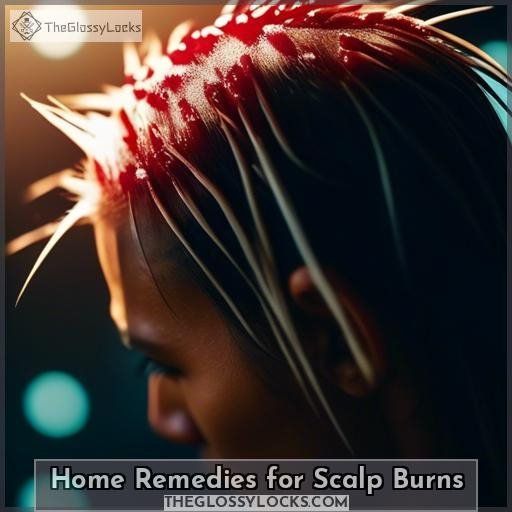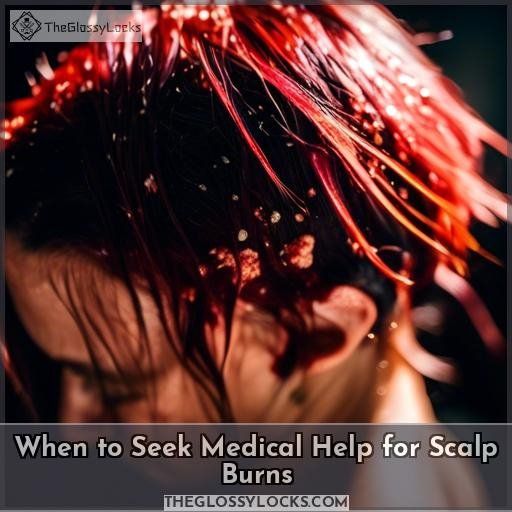This site is supported by our readers. We may earn a commission, at no cost to you, if you purchase through links.
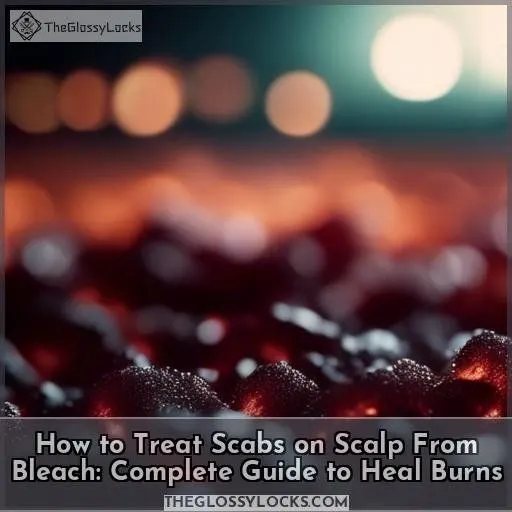
To treat scabs on scalp from bleach, you’ll want to keep the area moisturized with a thick, zinc-based conditioner.
Don’t pick at the scabs; let them fall off naturally.
You can rinse with chamomile tea or apply aloe vera gel to soothe irritation.
If scabs don’t improve within a week, you may need an anti-inflammatory medication or antibiotic ointment prescribed by a dermatologist.
Proper aftercare is vital for healing chemical burns, so be attentive in caring for your scalp to prevent further damage or infection during this vulnerable time.
Continue reading to discover a thorough guide on healing scalp burns from bleaching mishaps.
Table Of Contents
- Key Takeaways
- How to Treat Scabs on Scalp From Bleach?
- What Causes Scalp Burns?
- How to Prevent Scalp Burns?
- Symptoms of Scalp Burns
- Immediate Treatment for Scalp Burns
- Healing Process for Scalp Burns
- Alternative Treatments for Scalp Burns
- How to Avoid Scalp Burns After Bleaching
- Treatment for Scalp Burns Caused by Bleach
- Home Remedies for Scalp Burns
- When to Seek Medical Help for Scalp Burns
- Conclusion
Key Takeaways
- Keep scabs moisturized with a thick, zinc-based conditioner and let them fall off naturally.
- Use chamomile tea or aloe vera gel to soothe irritation.
- If scabs don’t improve within a week, consult a dermatologist for an anti-inflammatory medication or antibiotic ointment.
- Proper aftercare is essential to prevent further damage or infection during the vulnerable healing time.
How to Treat Scabs on Scalp From Bleach?
To treat scabs on your scalp from bleach, follow these steps:
- Immediately rinse the bleach from your scalp using water. Wear gloves to protect your hands.
- Continue flushing the affected area with cool running water for at least 10 minutes. Allow the water to run freely off of your scalp without pooling.
- Avoid rubbing, scratching, or wiping your scalp.
- Use a cool compress to help with pain and swelling.
- Take over-the-counter (OTC) pain relievers such as ibuprofen, naproxen, or acetaminophen to relieve pain and swelling.
- Keep the affected area clean to prevent infection.
If the scab is severe, deep, or covers a large area, seek immediate medical attention.
What Causes Scalp Burns?
Scalp burns from bleaching can occur due to several chemical factors. The primary culprits are high concentrations of hydrogen peroxide (above 6%) and the inclusion of persulphates in bleaching formulas, which accelerate the bleaching process but also increase tissue damage; additionally, alkalizers found in dust-free bleach powders contribute to chemical burns by causing necrosis of the scalp tissue.
Chemical Burn Causes
Chemical burns on the scalp can be caused by various factors, including bleach application. Bleach, a strong alkaline cleaning product, can cause skin irritation and damage when it comes into contact with the scalp.
The concentration of hydrogen peroxide in bleach plays a significant role in causing burns, with higher concentrations increasing the risk of injury. Additionally, hormonal changes during menstruation increase scalp vascularity, making the scalp more susceptible to bleach burns.
To prevent scalp burns, it’s essential to build up scalp oils by not shampooing for several days before bleaching and to apply a thick conditioner from the scalp to the tips before bleaching.
If a burn does occur, immediate treatment includes taking anti-inflammatory medication, performing a milk rinse, applying conditioner with zinc pyrithione, and keeping hair in a ponytail with conditioner for at least a day.
Scalp burns typically heal within a week with proper care, but dandruff may occur as skin cells turn over, and an anti-dandruff shampoo can be used to manage it.
Prevention Measures
To avert scalp burns from bleach, it’s vital to adhere to proper training and standard guidelines.
Hairdressers should be instructed to apply bleach safely and steer clear of contact with the scalp.
Additionally, utilizing a plastic cap and hood dryer for a brief time can aid in minimizing the risk of burns.
Accumulate scalp oils by refraining from shampooing for several days before bleaching.
Apply a dense conditioner from the scalp to the tips before bleaching.
If scalp burning arises during the process, inform the colorist immediately to rectify the application or take a break.
Immediate Treatment Options
Immediate treatment for scalp burns caused by bleach is essential to prevent serious harm. Here are five steps to take:
- Anti-inflammatory medication: Take anti-inflammatory medication to lessen swelling and fluid leakage.
- Milk rinse: Perform a milk rinse by pouring chilled milk over the scalp three times.
- Conditioner with zinc pyrithione: Apply conditioner with zinc pyrithione from root to tip.
- Ponytail method: Keep hair in a ponytail with conditioner for at least a day.
- Avoid picking: Avoid picking at scabs to prevent hair loss.
How to Prevent Scalp Burns?
To shield your crown from the fiery kiss of bleach, armor up with pre-bleaching care. Here’s your battle plan:
- Salon Safety: Partner with a stylist who wields bleach like a seasoned knight, following the sacred salon safety protocols.
- Scalp Protection: Don’t strip your scalp’s natural oils; let them build a few days pre-bleach.
- Avoiding Chemical Damage: Treat your tresses to a coconut oil mask, a knight’s shield against harsh chemicals.
- Hair Care Rituals: Condition your mane thoroughly, from root to tip, before the alchemical transformation.
- Doctor Consultation: If the burn saga unfolds, seek a healer’s wisdom promptly to avoid the need for hair transplant surgery.
Symptoms of Scalp Burns
You’ll recognize scalp burns from bleaching if you notice redness, swelling, blisters, or crusting on your scalp. These symptoms indicate chemical damage to the skin, and you should avoid aggravating the area by rubbing, scratching, or wiping the scalp while it heals.
Use standard guidelines for bleaching
To prevent scalp burns when bleaching your hair, follow standard guidelines provided by your hairdresser.
These guidelines can help you avoid chemical burns from hydrogen peroxide concentrations above 6%.
They also help avoid the use of caustic chemicals and alkalizers.
By adhering to these guidelines, you can minimize the risk of deep dermal burns.
These burns may lead to hospitalization, surgical excision, grafting, scar revision, and even permanent hair loss.
Avoid rubbing
Avoid rubbing your scalp to prevent further injury or irritation. Moisturize your scalp to protect and soothe the area, relieving pain and reducing the risk of infection. Aloe vera gel is a natural remedy that can help heal scabs from bleach. Remember to keep your scalp clean and avoid scratching, as this can worsen the condition.
scratching
If you’re experiencing scabs on your scalp, it’s crucial to refrain from scratching as it can exacerbate the condition.
Immediate treatment involves administering anti-inflammatory medication and conducting a milk rinse.
Home remedies such as tea tree oil and aloe vera gel may prove beneficial for dandruff and psoriasis.
Preventative measures include promoting scalp oils and communicating with your colorist if scalp discomfort arises during the bleaching process.
The healing process generally transpires within a week, and dandruff may manifest as skin cells shed.
Alternative approaches, such as restoring hair color to brown, can aid in preventing future scalp burns.
or wiping the scalp
If you have scabs or sores on your scalp and you’re concerned about the possibility of scalp burns, there are several things you can do to prevent or treat the issue. First, it’s crucial to identify the symptoms of scalp burns, which can include skin irritation, increased scalp vascularity due to hormonal changes, or a lack of scalp oil protection from recent shampooing.
To prevent scalp burns, you should avoid bleaching during menstruation, build up scalp oils by not shampooing for several days, apply coconut hair masks overnight before bleaching, and use a thick conditioner from scalp to tip before bleaching. Additionally, notify your colorist if scalp burning occurs during the bleaching process.
If you experience a scalp burn, you should take anti-inflammatory medication for swelling and fluid leakage, perform a milk rinse by pouring iced milk over the scalp three times, apply conditioner with zinc pyrithione from root to tip, and keep your hair in a ponytail with conditioner for at least a day. Avoid picking at scabs to prevent hair loss, and the scalp typically heals within a week with proper care.
For alternative treatments, you can consider dyeing your hair back to brown to avoid future scalp burning. Home remedies for scalp burns include tea tree oil, which is effective for dandruff and psoriasis, aloe vera gel, which may be effective for psoriasis, and fish oil or omega-3 supplements, which may reduce inflammation in eczema and psoriasis.
If you suspect a scalp burn, it’s pivotal to seek medical help if symptoms worsen or show signs of infection.
deep
Delving into scalp burns, it’s imperative to equip yourself with scalp protection against bleach’s unforgiving effects.
Should your scalp succumb to sensitivity, overhaul your hair care regimen with alternative remedies.
Incorporate tea tree oil and omega-3 supplements to strengthen scalp health.
Mastering the art of treating scabs on the scalp from bleach is your secret weapon for hair triumph.
or not improving over time
If your scabs on the scalp aren’t getting better or are accompanied by symptoms like skin irritation, scalp irritation, fungal infection, or contagious parasites, it’s essential to seek professional help. Here are some guidelines to follow:
- Avoid irritants: Stop using any hair products that may cause an allergic reaction or worsen your condition.
- Check for infections: If you suspect a fungal infection or head lice, consult a healthcare professional for proper diagnosis and treatment.
- Home remedies: Aloe vera gel, fish oil supplements, or eosinophilic folliculitis treatments may provide relief for certain scalp conditions.
- Professional intervention: If your symptoms persist or worsen, consult a dermatologist for a personalized treatment plan.
Immediate Treatment for Scalp Burns
When you experience a scalp burn, prompt treatment is essential to prevent complications.
Begin by taking pain relievers to reduce inflammation and fluid leakage.
Perform a milk wash by pouring chilled milk over your scalp three times. Apply hair conditioner with zinc pyrithione from root to tip. Keep your hair in a ponytail with conditioner for at least a day.
Resist picking at scabs to avoid hair loss.
The scalp typically heals within a week with appropriate care.
Use dandruff shampoo to manage dandruff.
If your burn is severe, consider coloring your hair back to brown to prevent future scalp burning.
Healing Process for Scalp Burns
The healing process for scalp burns involves patience and proper care.
As your scalp peels, it’s essential to refrain from picking at scabs to prevent hair loss and infection.
Dandruff may occur as skin cells turn over, so use an anti-dandruff shampoo to address it.
To prevent scars, maintain the scalp’s cleanliness and moisture.
If you have concerns about infection or scarring, seek medical advice.
Alternative Treatments for Scalp Burns
After exploring the healing process for scalp burns, it’s time to delve into alternative remedies.
For those seeking natural solutions, several home remedies merit consideration.
Aloe vera gel, for example, may prove efficacious for psoriasis.
Tea tree oil is another potential option, especially for dandruff and psoriasis.
Additionally, fish oil or omega-3 supplements can aid in reducing inflammation associated with eczema and psoriasis.
Hydration is paramount for scalp well-being, so it’s essential to maintain adequate water intake and utilize hair products that foster hydration.
Please note that these are alternative treatments and should not serve as substitutes for professional medical guidance.
How to Avoid Scalp Burns After Bleaching
To avoid scalp burns after bleaching, consider these tips:
- Coconut Oil Hair Mask: Apply coconut oil to your hair before bleaching to protect your scalp.
- Premenstrual Hormones: Avoid bleaching during menstruation to prevent increased scalp vascularity.
- Scalp Oil: Build up scalp oils by not shampooing for several days before bleaching.
- Thick Conditioner: Apply a thick conditioner from scalp to tip before bleaching to create a protective barrier.
Treatment for Scalp Burns Caused by Bleach
Regarding the treatment of bleach-induced scabs on your scalp:
Refrain from using bleach during premenstrual fluctuations, as this can increase scalp vascularity and potentially cause burns.
Accumulate scalp oils by abstaining from shampooing for several days prior to bleaching.
Before bleaching, apply a generous amount of conditioner from scalp to tip and notify your colorist if any scalp burning sensations arise during the procedure.
For immediate treatment, administer anti-inflammatory medication, perform a milk rinse, and apply conditioner containing zinc pyrithione.
Secure your hair in a ponytail with conditioner for at least 24 hours and refrain from picking at scabs to prevent hair loss.
Scalp burns generally heal within a week with appropriate care, but dandruff may manifest as skin cells regenerate.
Employ anti-dandruff shampoo to alleviate dandruff.
Home Remedies for Scalp Burns
- Green Tea or Chamomile Tea: Soak two tea bags in lukewarm water and gently massage onto the scalp. The antioxidants in these teas can soothe stings and reduce inflammation.
- Milk: Soak a washcloth in cold milk and apply it to the scalp for up to five minutes. Milk has enzymes and proteins that promote healing and coolness that reduces inflammation.
- Tea Tree Oil: Dilute tea tree oil with water or baby shampoo before applying to the scalp. It has antiseptic properties that promote healing.
- Aloe Vera Gel: Apply aloe vera gel to the scalp to reduce pain and inflammation, stimulate skin growth, and repair damaged skin.
- Essential Oils: Use essential oils like lavender, rosemary, tea tree, and vetiver in a carrier oil to create a soothing blend for the scalp.
Additionally, consider using apple cider vinegar or baking soda in your hair care routine to balance the pH of the scalp and promote healing. Remember to avoid direct sunlight and use gentle, sulfate-free shampoos to protect the scalp during the healing process.
When to Seek Medical Help for Scalp Burns
If you encounter a scalp burn, it’s vital to determine when to seek medical assistance. While numerous scalp burns can be addressed at home, there are circumstances where you should consult a healthcare provider. Here are some guidelines on when to seek assistance and what steps to take:
- Severe Burns: If your scalp burn is severe, resulting in extensive blistering, or if you suspect a third-degree burn, seek immediate medical attention. These burns can lead to infection and may necessitate surgical intervention, such as skin grafts.
- Infection: If you observe signs of infection, such as increasing pain, redness, swelling, or pus, consult a doctor. They may prescribe antibiotics to treat the infection and prevent further complications.
- Persistent Pain: If your scalp burn isn’t improving despite home treatment and you’re experiencing persistent pain, it’s advisable to consult a healthcare professional. They may recommend additional treatments or pain management strategies.
- Underlying Conditions: If you have a history of autoimmune diseases, diabetes, or other conditions that may affect your scalp, it’s essential to inform your doctor. They may need to adjust your treatment plan based on your overall health.
- Pregnancy or Menopause: If you’re pregnant or going through menopause, your hormonal changes may affect your scalp’s sensitivity. In these cases, it’s critical to seek counsel from a healthcare professional to ensure appropriate treatment.
Remember that prompt intervention is key to managing scalp burns effectively. If you’re uncertain about the severity of your burn or if home treatment isn’t alleviating the condition, don’t hesitate to consult a doctor.
Conclusion
Unquestionably, 25% of people who bleach their hair suffer scalp burns.
[Keypoints]Carefully manage scabs on the scalp from bleach by:
- Keeping them moist with zinc-based conditioners
- Letting them fall off naturally
- Relieving irritation with chamomile tea or aloe vera gel
- Seeking medical attention if no improvement occurs within a week
Diligent aftercare is crucial for:
- Healing chemical burns
- Preventing further damage
- Ensuring the scalp’s rapid recovery

